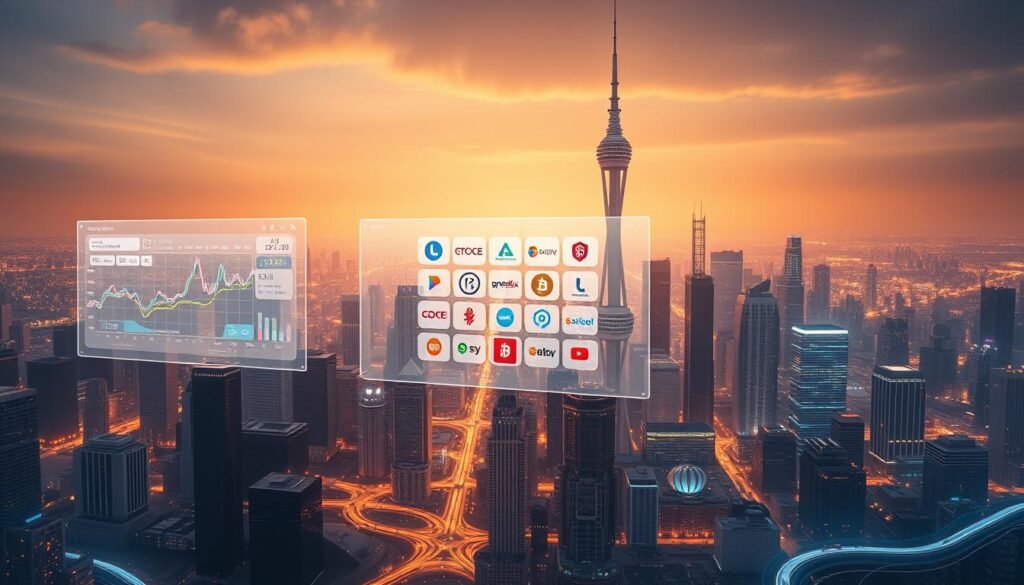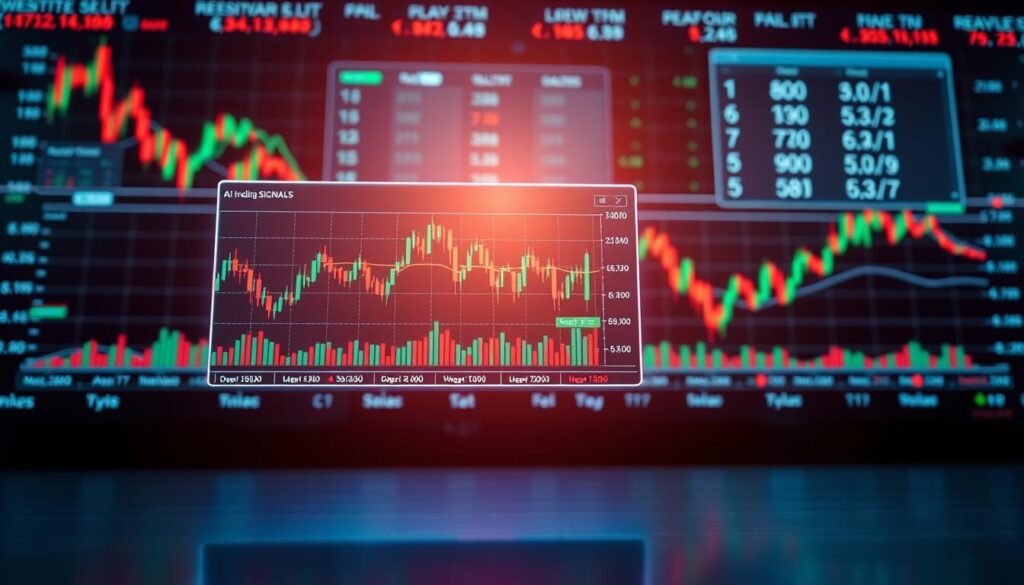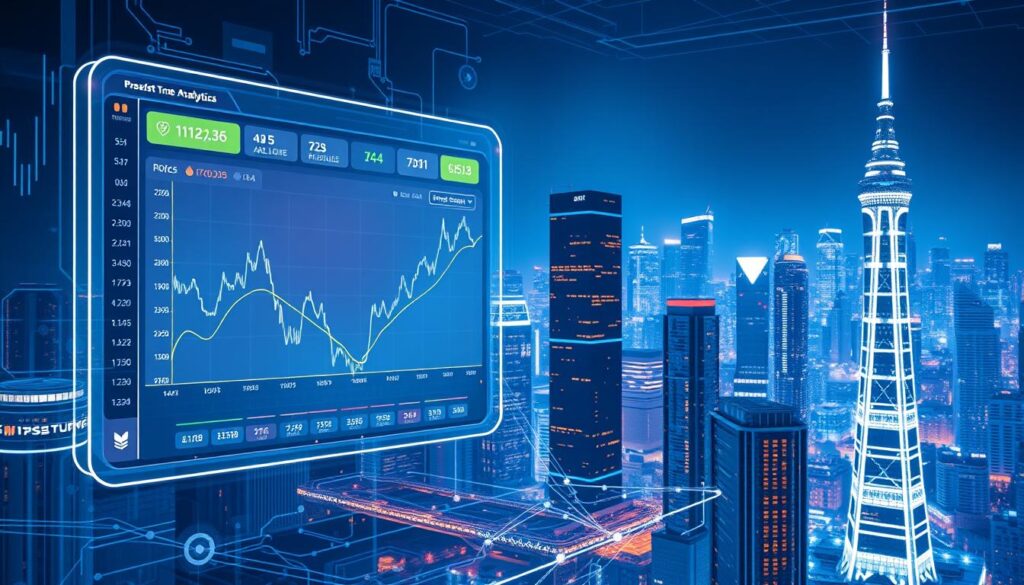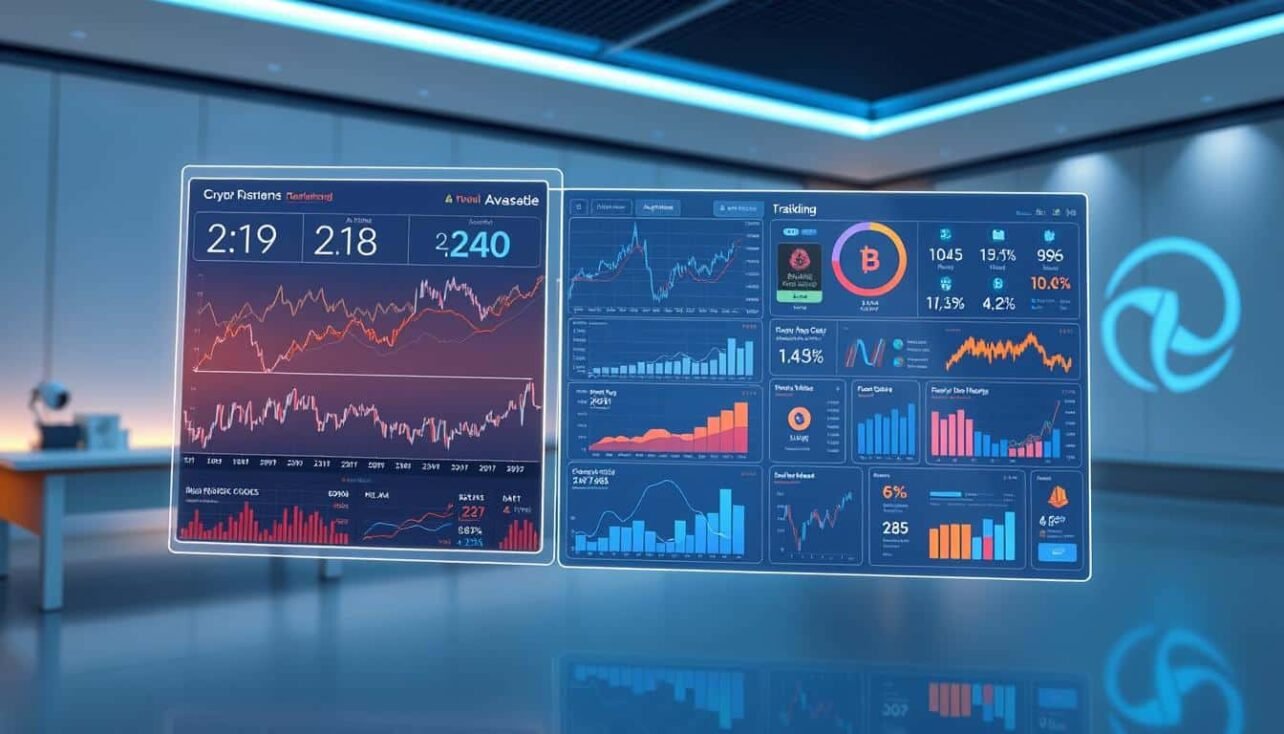The world of digital asset trading has entered a new era. Cutting-edge systems now process billions of data points daily, identifying patterns human traders might miss. These solutions combine live market feeds with advanced algorithms to spot emerging opportunities across blockchain networks.
Modern platforms analyze everything from social sentiment to exchange activity. They track shifts in trading volumes and liquidity pools faster than traditional methods. This technology helps users make decisions backed by real-time metrics rather than speculation.
Key Takeaways
- Next-gen systems process market data 24/7 to detect emerging trends
- Algorithmic analysis combines technical indicators with network activity
- Trading platforms now offer automated signal generation and portfolio management
- Real-time monitoring covers hundreds of digital assets simultaneously
- Data-driven insights reduce reliance on guesswork in volatile markets
Leading platforms like TMAI deliver instant alerts about potential breakouts. Users can explore advanced analysis methods that adapt to changing market conditions. These systems learn from historical patterns while adjusting to new regulatory developments.
The best solutions offer more than just predictions. They provide actionable strategies for portfolio diversification and risk management. By automating repetitive tasks, traders gain time to focus on strategic decision-making.
Overview of AI powered cryptocurrency price prediction tools
Financial markets evolve rapidly, demanding smarter solutions for digital asset evaluation. Modern systems combine pattern recognition with live metrics to decode market behavior. These platforms track everything from exchange flows to global economic events, creating dynamic forecasting models.
How Computational Models Reshape Forecasting
Traditional chart reading struggles with market complexity. Next-gen solutions process historical patterns and real-time metrics simultaneously. They cross-reference social media buzz with blockchain transactions, spotting trends before they surface on charts.
Self-improving algorithms adjust to regulatory changes and new token launches. This adaptability helps users stay ahead in fast-moving markets. Systems now evaluate hundreds of assets while calculating risk-reward ratios automatically.
Strategic Advantages for Market Participants
These platforms offer distinct benefits for portfolio management:
- Emotion-free decision frameworks based on live metrics
- Continuous tracking of emerging coins and established assets
- Custom alerts for liquidity shifts and volume spikes
| Traditional Methods | Modern Approach | Impact |
|---|---|---|
| Manual chart analysis | Automated pattern detection | Faster signal generation |
| Limited data sources | Multi-platform data aggregation | Broader market view |
| Static risk models | Dynamic risk assessment | Improved capital protection |
By merging quantitative analysis with network activity metrics, these systems identify undervalued opportunities. Users gain institutional-level market insights without requiring technical expertise. Real-time dashboards simplify complex data into actionable strategies.
Exploring AI and Machine Learning in Crypto Trading
Market analysis techniques have undergone radical transformation through computational innovation. Modern platforms now decode complex patterns using layered mathematical frameworks that evolve with market behavior. These solutions process information at unprecedented speeds while maintaining accuracy across volatile conditions.

Advanced Algorithms Behind the Tools
Neural networks form the backbone of contemporary trading systems. These frameworks analyze years of market data to identify subtle correlations between events and price shifts. By processing thousands of variables simultaneously, they detect opportunities invisible to manual analysis.
Supervised learning models train on historical patterns to forecast market movements. They cross-reference technical indicators with liquidity changes across exchanges. Reinforcement techniques then refine these predictions through continuous feedback loops, adapting strategies to sudden volatility spikes.
Natural language processing scans global news sources and social platforms in real time. This helps gauge collective sentiment before it impacts asset values. Ensemble methods combine multiple models to create resilient prediction engines capable of handling erratic market swings.
Cutting-edge systems now integrate quantum computing principles for faster calculations. These advancements enable microsecond reactions to emerging trends across crypto markets. The result? Decision-making frameworks that combine mathematical precision with adaptive intelligence.
Review of Top-Rated Crypto Prediction Platforms
Market participants face countless options when selecting forecasting solutions. Leading services combine distinct technical frameworks with tailored interfaces for different experience levels. Short-term forecast accuracy among premium platforms ranges from 70-85% across major trading pairs.

Comparative Analysis of Features
Top-tier tools prioritize customizable dashboards and multi-exchange integration. Advanced charting capabilities help users visualize market movements alongside predictive signals. Some services offer automated portfolio rebalancing based on live analysis results.
Three critical differentiators emerge:
- Backtesting modules that simulate strategies against historical data
- Real-time alert systems for sudden liquidity shifts
- API connectivity with popular trading terminals
Pricing models vary dramatically across products. Entry-level plans often include basic charting tools, while institutional packages provide dedicated support teams. Service reliability proves crucial – even minor downtime during market swings can impact profitability.
The best platforms balance sophisticated features with intuitive design. Mobile-responsive interfaces allow traders to monitor positions and adjust strategies from any device. Several services now incorporate community voting systems to validate prediction models.
Real-Time Trading Signals and Hidden Gem Discovery
Speed defines success in today’s fast-paced digital markets. Traders need instant updates and early access to rising assets to maximize returns. Modern systems achieve this through automated scanning and pattern detection across global exchanges.

How Emerging Tokens Get Identified
Sophisticated algorithms evaluate multiple factors to spot potential winners:
- Liquidity changes across decentralized exchanges
- Developer team activity on GitHub repositories
- Social media engagement growth rates
- Smart contract audit results and protocol updates
These systems compare new launches against historical success patterns. They flag assets showing rapid community growth before major price movements occur.
Non-Stop Market Monitoring Features
Round-the-clock analysis provides three key advantages:
- Immediate alerts when volatility spikes or trends reverse
- Personalized recommendations based on portfolio goals
- Natural language queries about market shifts
For example, TMAI can explain why specific tokens gain traction while others stall. Users get actionable insights without sifting through charts manually.
Platforms offering smarter trading strategies combine these features with risk filters. This helps traders focus on high-probability opportunities while avoiding market noise.
API Integration: The Engine Behind Real-Time Data
Behind every real-time update lies a complex network of data highways. These digital pathways connect trading platforms with live market information through standardized protocols. Application Programming Interfaces (APIs) act as translators, letting different systems exchange critical details without human intervention.

Understanding Endpoints and Data Formats
Modern trading services use two primary API architectures. RESTful systems provide multiple access points for specific data types like price histories or exchange volumes. Each request returns predefined information packages in JSON format – the universal language for web-based data exchange.
GraphQL takes a different approach. This protocol lets applications ask for exact data fields through single queries. It reduces unnecessary information transfers, making systems faster and more efficient. Developers appreciate its flexibility when building custom dashboards.
| Feature | REST API | GraphQL |
|---|---|---|
| Requests Needed | Multiple | Single |
| Data Control | Server-side | Client-side |
| Response Format | Fixed Structure | Customizable |
WebSocket connections push updates instantly instead of waiting for requests. This streaming capability ensures traders receive price changes the moment they occur. Combined with proper authentication, these protocols create secure data pipelines for global markets.
Rate limits prevent system overloads while maintaining access for authorized users. Clear documentation helps developers integrate these services quickly. Together, these elements form the backbone of modern trading applications.
Data Analytics and Market Insights in Crypto Trading
Accurate market analysis starts with trustworthy data streams. Modern trading platforms rely on precise information flows to detect patterns and forecast movements. Without verified inputs, even advanced systems risk generating flawed strategies.
Building Trust Through Verification
Reliable analytics demand rigorous validation processes. Leading platforms implement three core safeguards:
- Timestamp synchronization across global exchanges
- Multi-source cross-checking for conflicting reports
- Automated discrepancy alerts with resolution protocols
These measures prevent outdated or manipulated figures from skewing results. Traders gain confidence knowing their decisions rest on verified information.
| Data Challenge | Modern Solution | Benefit |
|---|---|---|
| Delayed updates | Millisecond timestamp matching | Real-time accuracy |
| Exchange discrepancies | Consensus algorithms | Unified market view |
| Anomalous spikes | Pattern recognition filters | Noise reduction |
Sophisticated correlation models reveal hidden connections between market events. By analyzing trading volumes alongside social trends, systems identify emerging opportunities earlier. Statistical models then assess potential outcomes based on historical parallels.
Continuous monitoring systems track 40+ quality metrics across data feeds. Alerts trigger automatically when values fall outside expected ranges. This proactive approach maintains integrity across constantly shifting market conditions.
Comparing Crypto Trading Strategies and Tools
Market participants constantly seek optimal methods to navigate volatile digital markets. Selecting the right approach requires understanding how different techniques perform under pressure. This comparison examines key metrics that separate effective systems from outdated models.
Historical Performance and Predictive Accuracy
Algorithmic approaches demonstrate clear advantages in backtested results. Data from 2021-2023 shows automated systems achieved 23% higher annual returns than manual trading. These models also reduced portfolio drawdowns by 40% during market corrections.
Three factors contribute to superior outcomes:
- Multi-layered risk assessment protocols
- Real-time adjustment capabilities
- Cross-market correlation analysis
Machine learning models combining decision trees and neural networks show particular strength. These hybrid systems maintain 72-78% accuracy for 3-day forecasts across major tokens. Traditional chart-based methods typically score below 60% in similar tests.
| Approach | Annual Return | Accuracy (72hr) |
|---|---|---|
| Manual Analysis | 14% | 58% |
| Basic Algorithms | 27% | 68% |
| Advanced Systems | 37% | 76% |
Strategy optimization occurs through continuous feedback loops. Modern platforms recalibrate parameters weekly using fresh market data. This adaptability proves crucial when regulations shift or new tokens enter exchanges.
Medium-term predictions (1-7 days) yield the most reliable results. Systems analyze liquidity patterns and holder behavior to forecast probable price ranges. Traders use these insights to balance short-term gains with long-term positioning.
Securing Investments: Compliance and Cybersecurity Measures
Protecting digital assets demands robust security frameworks that evolve with emerging threats. Modern trading platforms implement layered defenses to shield user accounts and transaction pipelines from breaches. These measures combine technical safeguards with regulatory adherence to create trustworthy environments.
Best Practices for API Key and Data Protection
API keys act as gateways to sensitive financial operations. Never store these credentials in client-side code where hackers might intercept them. Instead, use encrypted server environments or dedicated secrets management tools with strict access controls.
Three essential practices enhance key security:
- Rotate credentials every 30-90 days to limit exposure windows
- Apply granular permissions through scope limitations
- Monitor usage patterns for abnormal activity
Short-lived tokens add another protection layer for high-risk transactions. Combine this with IP whitelisting to restrict access to verified networks. Platforms should also enforce rate limits to prevent brute-force attacks on authentication systems.
Data protection extends beyond encryption during transmission. Regular backups stored in geographically dispersed locations ensure recovery options during crises. Compliance with standards like GDPR demonstrates commitment to user privacy while avoiding legal penalties.
| Risk | Solution | Benefit |
|---|---|---|
| Key leakage | Hardware security modules | Physical protection |
| Unauthorized access | Multi-factor authentication | Identity verification |
| Data corruption | Immutable backups | Recovery assurance |
Continuous monitoring systems scan for suspicious login attempts and API usage spikes. Automated alerts enable rapid response teams to contain threats before escalation. Regular audits maintain compliance as financial regulations adapt to new market realities.
The Role of Blockchain in Enhancing Prediction Accuracy
Blockchain networks are rewriting the rules of market analysis through transparent, tamper-proof recordkeeping. Every transaction and wallet movement leaves an indelible mark across distributed ledgers – creating rich datasets for evaluating market behavior.
Merging Chain History with Market Signals
Sophisticated systems now track token flows between addresses in real time. This reveals accumulation patterns by large holders before major price shifts occur. Smart contract interactions and mining activity add layers of context to traditional metrics.
Three critical advantages emerge from this integration:
- Verifiable proof of exchange reserves and token distribution
- Early detection of whale movements across networks
- Objective tracking of protocol upgrades and governance changes
A comprehensive study demonstrates how combining blockchain data with market signals improves forecast reliability by 34%. Systems analyze mining rewards, staking activity, and gas fees to gauge network health beyond surface-level metrics.
This approach transforms raw chain data into actionable insights. Traders spot emerging trends in decentralized finance markets while verifying token fundamentals. The result? More informed decisions grounded in cryptographic truth rather than speculation.


No comments yet